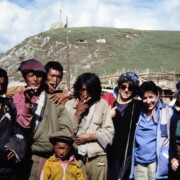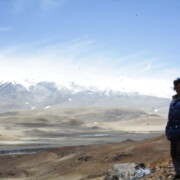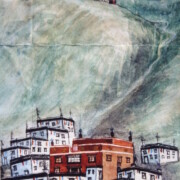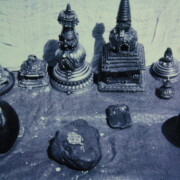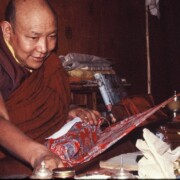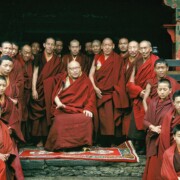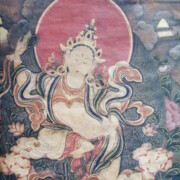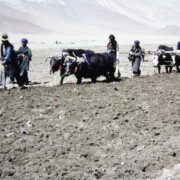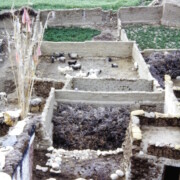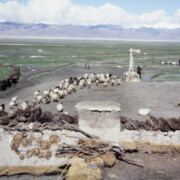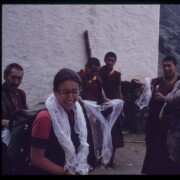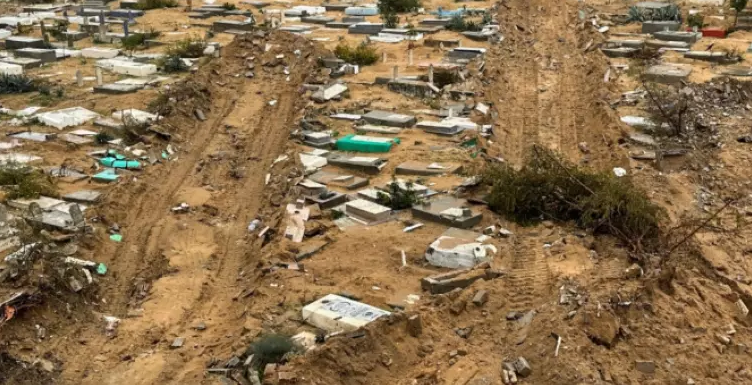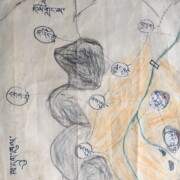available through Garuda Books
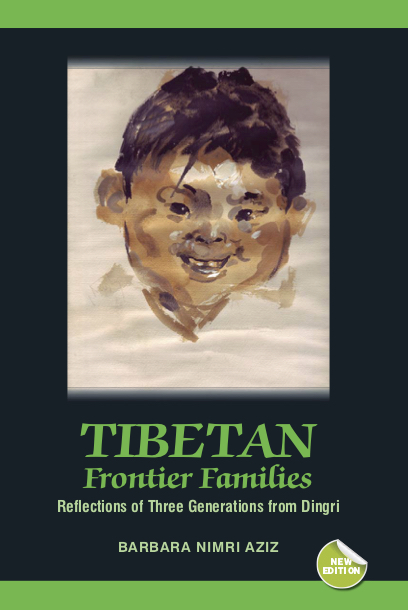
Still referenced 40 years on by Tibet scholars and anthropologists this interview-based portrait offers an unsurpassed socio-historical chronicle of three generations of Dingri people . In Tibetan Frontier Families, we have a classic ethnography composed from intensive talks with refugees in Nepal in 1970, former farmers and herders whose home had been a cluster of villages on the windy, arid plateau known as Dingri Maidan.
The new edition is augmented by Aziz’ later fieldwork inside Dingri itself:– three expeditions into this valley of southwest Tibet between 1985-1988. A chart of Dingri villages, composed by a Dingri refugee for her in 1970 became Aziz’ blueprint for oral reconstructions of their culture, then served a map for her anthropological forays within Tibet itself. She would venture by horse and foot village to village across the Dingri plain, into the very places from which the refugees had originated (see excerpt, below). Her many photographs identifying specific locations within what the author calls “The Sea of Dingri” are printed in the 2011 edition, and reproduced in this webpage.
With runoff from nearby Everest glaciers, residents continue to farm the harsh, windswept soil. Aziz observed that these hardy people not only survive under a neglectful Chinese rule which has left the area undeveloped. Villagers retain much of their past lifestyle in terms of marriage and family customs, agricultural labor, and rudimentary religious rituals. One finds no monks but a few nuns occupy and care for sacred places like Langkor and Rongbuk.
The body of Tibetan Frontier Families, assembled from personal family portraits details specific and the general characteristics of Tibetan society:- complex household structure, the interface of religion and social life, its foraging and herding economy as lived in Dingri’s austere alpine ecology. We learn what it means to be a simple nun or a monk living in or near villages as opposed to the assemblies of men studying in grand monastic edifices. We are introduced to marriage and family life, pottery and communal plowing, and the diversity of religious work and spiritual leadership. Thereby we grasp the rhythm of an extant and surviving, although wounded, civilization. (see photos under Fieldwork with Tibetans in Nepal and Nepal)
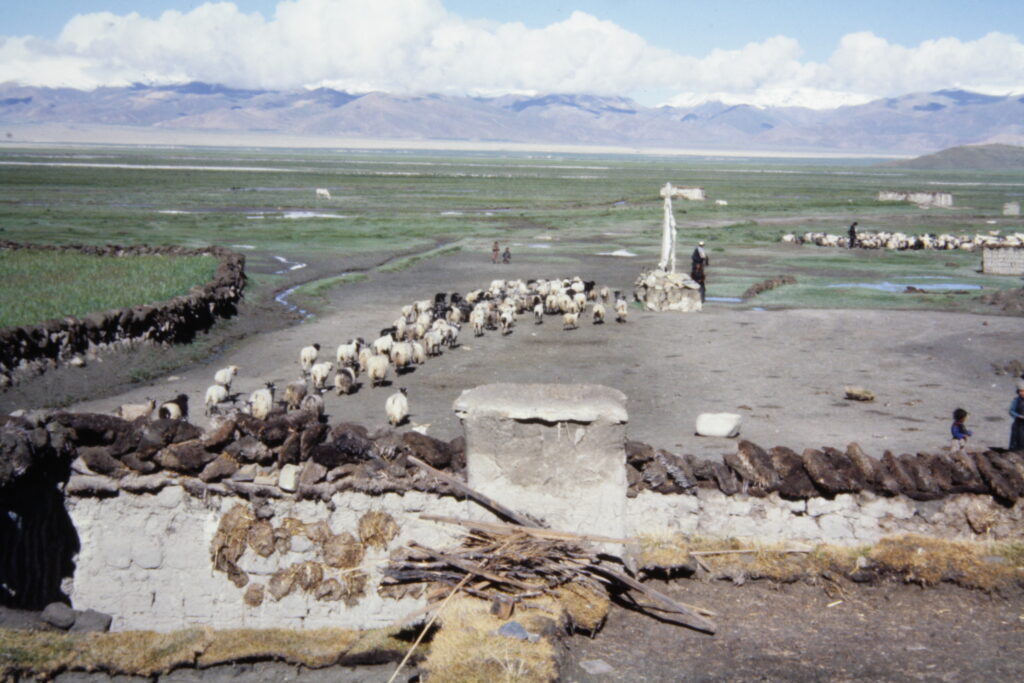
Into the 21st century, Dingri may be faring better than other parts of rural Tibet because of its proximity to Mt Everest. Some villagers gain employment with trekkers and mountaineers on their expeditions onto the north-facing slopes of the famous mountain. Tourism to Lhasa overland from Nepal takes people across the Dingri plain and many travelers thus stop there to view the spectacular landscape.
Excerpts
The sky was clear, cloudless blue, the sun piercing bright, and one could see far, far across the open Tibetan plain.
Dingri Maidan lay before me.
A biting wind erased any warmth that the seamless space above us may have promised. Arriving on the Dingri plain, I was eager to finally witness its daily life—what was left of it under Chinese rule. I would be pleasantly surprised, but I did not know what to expect on this first encounter.
I pulled in my chin and turned my face away from the sandy blast, squinting tightly to discern the terrain ahead of me.
I had written much about Dingri’s people but only from a distance. Fifteen years earlier I lived with Dingri refugees in Nepal. I expected the place they fled had since become a desolate scene. Now I would find out if anything endured decades of Chinese rule and the inclement environment.
On the surface the expanse around me certainly appeared desolate. This was before I stopped and conversed with its inhabitants, wandered through their humble settlements and closely examined craggy recesses of the landscape. On my second visit, in the early summer when streams flowed at our feet and green barley sprouted behind stone walls and turned the gritty earth green, I would discover just how much survived.
The slow revelation of the layers of a place’s life is what so enchants an anthropologist or biologist and helps us endure the discomforts that may attend our painstaking and sometimes-lonely work. That measured disclosure is the science of research too.
My first visit to Dingri was in early winter 1986. The entire valley appeared inhospitable. Houses, if one could distinguish them at all, were low stone dwellings huddling in a cluster on the rock-strewn plain, colorless, utterly bare of trees. I asked myself: “How do people sustain a culture here let alone eke out a living, raise sheep and horses, make themselves warm and clean, support priests and monasteries, dance and weave, and compose stories and poems, and nurse any children who survive beyond infancy only to toil similarly for yet another generation?”
I found the barrenness of the land all around me overwhelming then. If I had not so intimately studied the early 20th century history of this place from knowing its refugees in Nepal (recorded in the first edition of this book) I would not have been inclined to stop here at all.
Every season many hundreds of climbers and tourists pass through Dingri en route to the alluring North Everest (Jomolungma) base camp.
Yet so severe is the atmosphere that few pause to investigate life within it. They likely think the place is completely uninhabited. To them, little appears worth their attention except for that insensate rock and ice tower beyond. Surely these passersby conclude that any human form they may glimpse on the stony horizon must also be en route to somewhere else.
Over the course of three visits between 1986 and 1988, I would engage this place in various seasons. Week by week, moving into the terrain, I begin to notice sparse yet living flora clinging to the stony soil, pushing up through a rock crack: thick red lichens, a solitary yellow flower emerging from the fissures of a boulder, barbed green tips of submerged roots which will be harvested from the wild, first by sheep, then by children. I peer over a row of rocks piled to make a crude wall. (How is it they do not collapse in the relentless Tibetan wind?) Tenuous ‘though they appear they shelter modest fields of barley, tender and confidently green.
by B Nimri Aziz April 7, 2024. also on Counterpunch We wring our hands and shake our heads sadly as the toll mounts. Palestinian corpses…
Film review: by BNimri Aziz Feb 24, 2024 Author James Baldwin was more than a brilliant novelist; he was a powerful speaker, a compelling debater…
Feb 17/ 2024 by BNimri Aziz I know, I should be delighted by our mild(ish) winter weather. I’m not. Why? Not because I fear…
also carried in Counterpunch Feb 7, 2024 by Barbara Nimri Aziz It’s hard to imagine this happening in modern times. Even an assault on a…
By BNimri Aziz Dec 17, 2023 also carried on Counterpunch.com …and thinks for a moment an angel is therebringing back loveIf I must dielet it…
Dec 6, 2023 by BNimri Aziz also posted in Counterpunch What’s the world’s fascination with dead, dying and orphaned children? Wait, before you condemn what…

